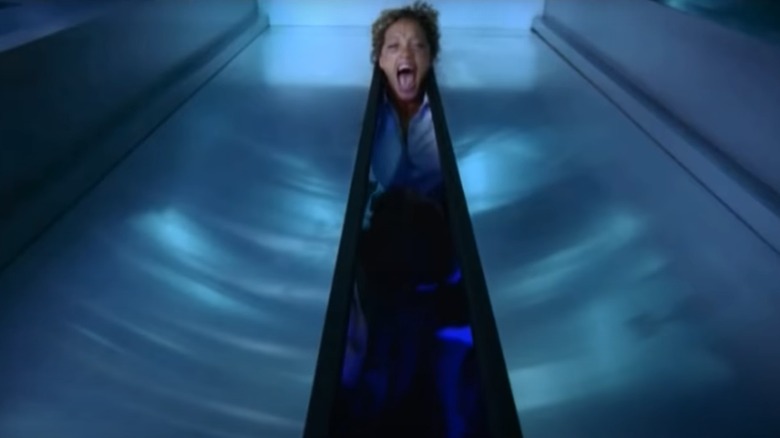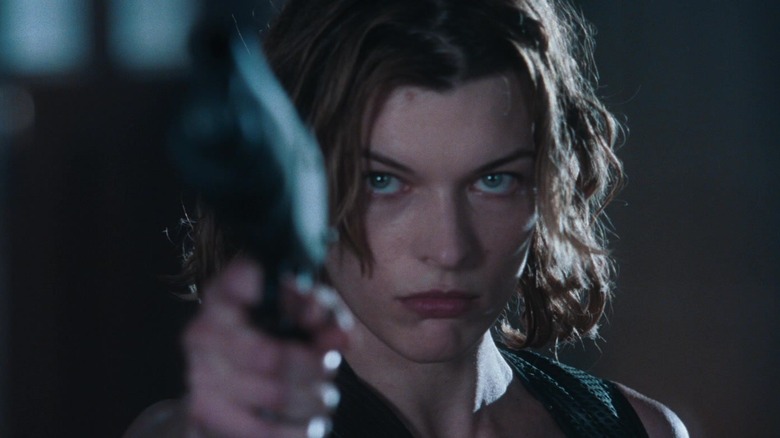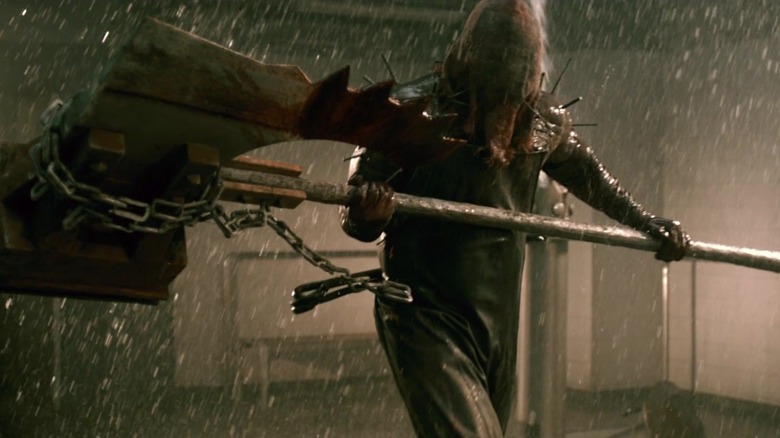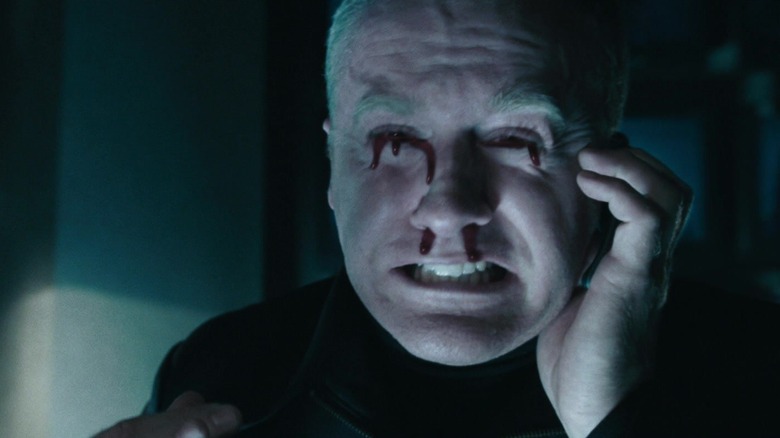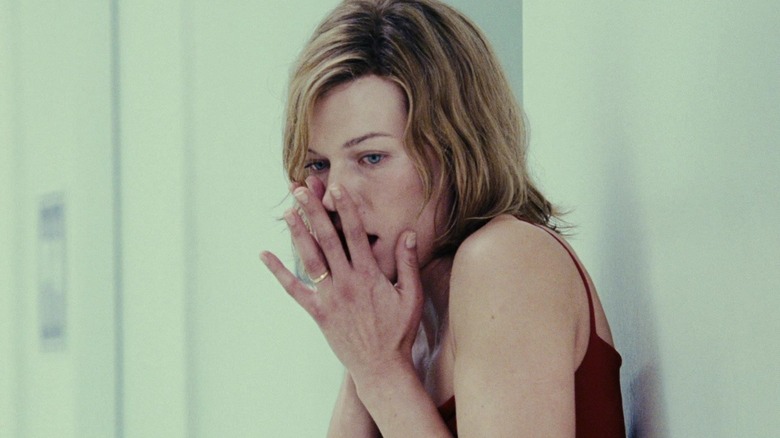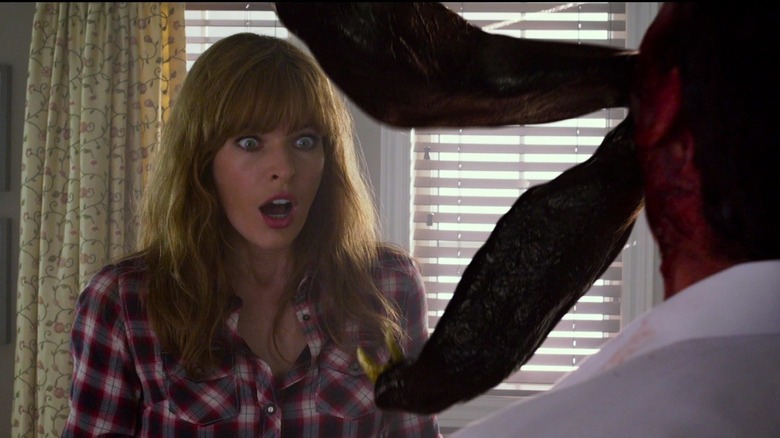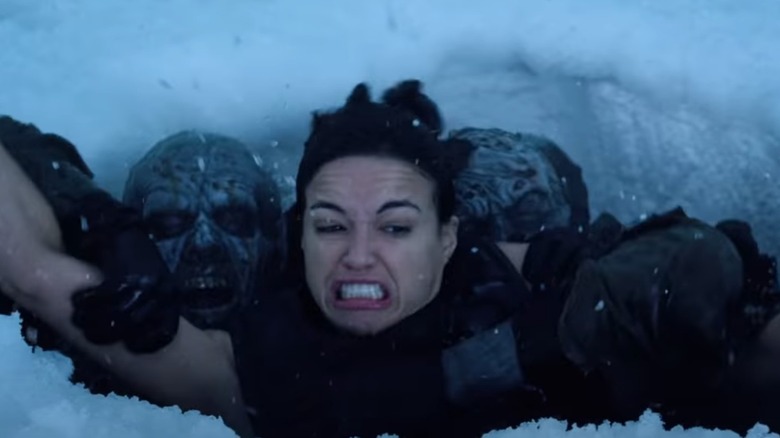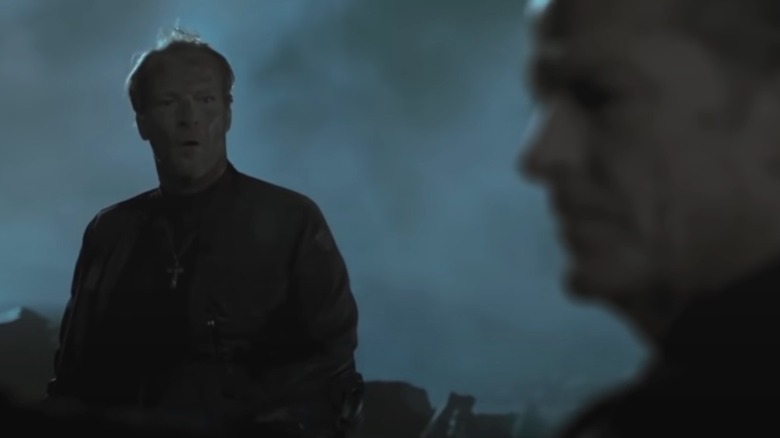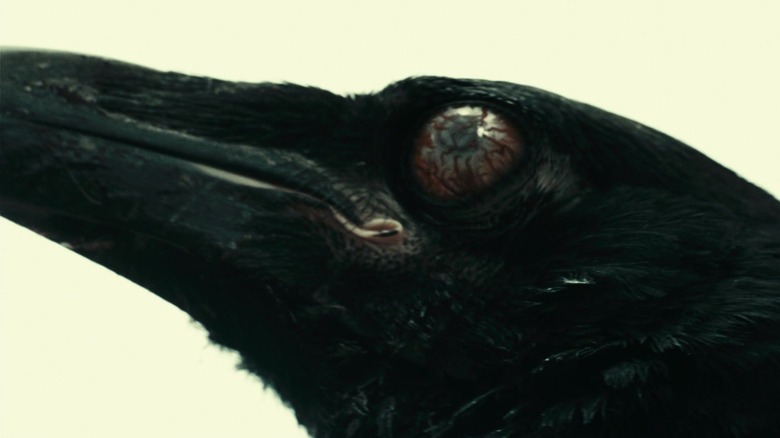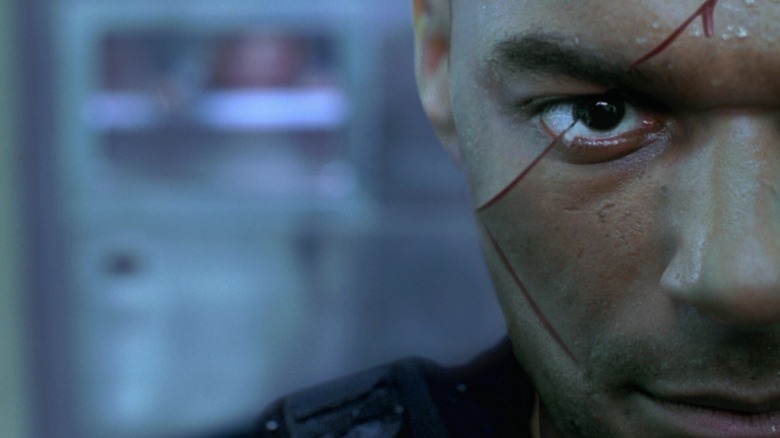The Craziest Death Scenes In Resident Evil
This content was paid for by Sony and created by Looper.
The "Resident Evil" franchise is the most successful video game adaptation in Hollywood history, a six-film buffet of shrieking zombies, spraying blood, and made-for-3D action set pieces produced over the course of 15 years by the husband-and-wife team of Paul W.S. Anderson and Milla Jovovich. Since the release of the first movie in 2002, "Resident Evil" has given fans of the zombie genre everything they could ask for: There are ravenous hordes of the undead storming the remains of civilization while wide-eyed survivors contemplate their morality and their mortality as they notice the bite wounds on their friends' hands. It's also more than just another zombie apocalypse story world. Science fiction elements like cloning, biological weapons, psychic powers, and artificial intelligence have been part of the franchise from the jump, and the films have also embraced the games' unbridled love of bizarre zombie mutants and grotesquely infected animals.
So when it comes to picking the gnarliest death scenes in "Resident Evil," there's a lot to choose from. Getting eaten by a zombie swarm or shakily turning your gun on yourself after getting bitten just isn't enough in a series where an army of Jovovich clones throw katanas through the heads of their enemies in one movie's opening scene. It takes creativity to get on this list, and creativity is one thing the "Resident Evil" movies have never lacke.
The elevator
One thing that makes the original "Resident Evil" such a great film is that it understands how suspense works. Everyone knows the zombies are coming, but you don't see one for the entire first third of the movie. That doesn't mean there are no deaths in the build-up, of course — on the contrary, the movie actually opens with a massacre, just not at the hands of zombies (instead, it's a ruthlessly logical artificial intelligence trying to contain the spread of infection). The gassing and drowning of the employees of the Hive is a horrifically effective way to kick things off, and it culminates with the elevator scene.
The poor victim of the moment doesn't even have a name, but we'll still never forget the sight of her poor head sticking out of the AI-controlled elevator after an ill-fated attempt at escape. It's not even the decapitation itself that makes this scene so intense — it's the chillingly inevitable sequence of events, from the camera catching her, to the fake-out with the elevator going down, to her panicked realization that it's about to go up. Again, this is a movie that understands suspense.
Hail motorcycle, full of gas
The original "Resident Evil" was unquestionably a horror film, but the second one, "Resident Evil: Apocalypse," has action movie written all over it, and nothing exemplifies this better than the church scene. While there is a wonderful pure horror moment with a priest and his chained up zombie sister, it is immediately followed up with the small group of survivors being menaced by three monstrous lickers.
They're saved by Jovovich's Alice, who makes her entrance by driving a motorcycle through the church window, sending it spinning into a licker, and blowing both of them to kingdom come with a couple of well-placed bullets. Alice follows this up by killing a second licker with a massive wooden crucifix and shooting the third in the head. Now sure, they're just mutated zombies and even by the second movie, lickers are a dime a dozen, but it's just such a ridiculously insane sequence of kills that it has to be included.
Axe to grind
Despite being the movie with the aforementioned clone army, "Resident Evil: Afterlife" takes a hard left turn after its big opening set-piece, blowing up all the clones, stripping Alice of her psychic powers, and re-grounding the franchise in its survival horror roots. And things get especially eerie once the Axeman shows up.
Based on the Executioner Majini character from the games, this massive villain wears a black hood over its head, has nails and spikes protruding from its face and shoulders, and wields an enormous axe with a hammer on one side. The unfortunate Kim Yong being vertically sliced in half would probably qualify as a wild death scene on its own, but the ensuing water-drenched fight scene between the Axeman, Alice, and Claire Redfield takes things up a notch, culminating in a sliding shotgun blast, a desperately dodged axe throw, and a head full of loose coins.
Smile for the camera
"Resident Evil" eventually pivoted back from horror and toward action in "Apocalypse," particularly towards the end of the movie, when Alice has been re-captured by the Umbrella corporation. While she initially seems to have lost her memory due to further experimentation, she quickly gets it back, takes down her captors, and breaks free from the facility. On her way out, however, she proves once again that she's far from a standard-issue action hero.
In a movie that features a giant zombie with a huge Gatling gun as its primary villain, there's nothing scarier than Alice staring through the lens of a security camera at the guard watching her through the screen, smiling and twirling her hair as blood begins to pour from his eyes and nose. It's the moment we realize that "Resident Evil" has just shifted in a fascinating new direction, that Alice is more formidable that she's ever been, and that nothing is entirely as it seems.
Alice dies
If you thought the ending of "Apocalypse" was wicked, try the beginning of the next film, "Resident Evil: Extinction," which introduces the concept of cloning to the franchise in the most dramatic way possible. The film's opening sequence is an almost note-for-note tribute to Jovovich's introduction in the first film, when she wakes up on the floor of the shower with no memory and wanders confusedly through her home. This time, instead of a group of commandos bursting through the windows, she makes her way through a series of traps, ultimately being shot by a high-tech drone.
It's a scene that delights in the audience's confusion as Alice moves from her house to the Hive to a Raccoon City hospital, three things that definitely shouldn't be adjacent to one another — and the last of which probably shouldn't have a giant guillotine blade dropping from the ceiling. Alice's death -– the first of many occasions, thanks to cloning technology -– is a gut punch that isn't exactly alleviated by the final shot of her body being thrown into a ditch with hundreds of others just like it.
Domestic disturbance
With the clone reveal coming at the beginning of "Extinction" and Alice mobilizing her own clones at the end, their attack on Umbrella in "Afterlife" packs a little less wallop at this point, because the sight of Alice dropping dead isn't quite as traumatizing anymore. "Resident Evil: Retribution," however, puts yet another new spin on things: Umbrella is using their clone technology to produce a wide variety of simulations, one of which features a happily married suburban version of Alice, with a daughter and a husband who's a clone of former Alice ally Carlos Oliveira.
Of course, in typical "Resident Evil" fashion, we don't know that until later on, because the film does a great job of keeping audiences guessing all the while. "Retribution" is a bold movie that ventures entirely off the rails at times, but it doesn't get wilder than the sight of a bewildered Alice fighting off the undead without the benefit of training or superpowers, accidentally impaling one of them on a staircase, and getting eaten by her zombie clone husband and his face tentacles.
Under the ice
In addition to finding new ways to use the idea of Alice clones, "Retribution" also brings back Jill Valentine — now blonde and a mind-controlled Umbrella villain — and Rain Ocampo, Michelle Rodriguez's character from the first film, who has also been cloned. Multiple versions of Rain show up over the course of the movie, but the most notable one is the evil one who injects herself with the horrifying Las Plagas parasite and becomes so fast and strong that not even Alice is a match for her.
This fight scene is one of the most visually striking in the "Resident Evil" series, taking place on a snowy field above a frozen body of water, and it only becomes more striking when Alice shoots the ice around Rain's feet, plunging her into the freezing –- and of course, zombie-infested — water. Very few images in the franchise are as violently beautiful as the horde of aquatic undead converging on Rain and dragging her down into the depths.
Assisted suicide
After the events of "Retribution," Iain Glen returns as Alexander Isaacs after last being seen at the end of "Extinction" being killed by Alice. Of course, it turns out that was a clone -– and so is the one who menaces Alice for most of "The Final Chapter." The real Isaacs shows up at the end of the movie as the mastermind behind everything that has happened in the franchise, and he has managed to enhance himself so thoroughly that he's practically impossible to defeat or kill.
In fact, the only person who can kill Isaacs is Isaacs himself, as the clone from earlier in the film, unable to accept the idea of not being the real Isaacs, stabs the original to death in a frenzy of hyper-religious fervor. Not only is this a metaphor in keeping with the general themes of "The Final Chapter," but it's also quite effective and jarring to see that the world is ultimately saved by a delusional clone turning on its creator.
An infection of crows
The "Resident Evil" movies have beautiful scenes, they have terrifying scenes, and they have creative scenes, but nothing combines all three of those things like the zombie crows sequence in "Extinction." It seems like such an obvious idea in retrospect: Why wouldn't scavenger species like crows start feasting on the infected dead and become infected themselves? But the scene itself delivers on the promise of that idea in breathtaking fashion, as the flock of undead birds sweeps over the survivors in their vehicles, remorselessly pecking away at faces and bodies and decimating the ranks of the remaining humans.
More primal than the dogs of earlier films, the scene gives you the feeling that nature itself has fallen to the T-virus, and with that feeling comes the dread of inevitability –- the cold, hard knowledge that this enemy can't be beaten. Which makes it even better when Alice shows up and uses her powers to not only stop the crows' advance, but to destroy them all in a flaming inferno that sweeps across the sky, framing her heroically against a raging backdrop of orange fire and black ash. If humanity has any hope at all, it lies in Alice. And if you have any doubt about that, ask the crows.
The laser grid
Last but not least, let's turn to the most iconic scene in the "Resident Evil" franchise, and one of the most iconic scenes in all of modern horror, which arrives in the very first movie before the arrival of a single zombie. The scene is such a fundamental part of "Resident Evil" that it gets two different callbacks in "Extinction" and appears again in "The Final Chapter." The series' most enduring villain, as it turns out, isn't Alexander Isaacs or Albert Wesker, but a grid of blue laser beams.
There are so many elements working in tandem here to make this scene effective. There's the fact that the hallway in which James Shade and his three team members are trapped in is brightly lit, for example, making the danger obvious while also being unavoidable. There's also the fact that the laser clearly has intelligence behind it, as it anticipates one commando's attempt to jump over it and slices him in half. The music is also unforgettable, as are the desperate attempts of those outside the hallway, particularly the team's thoroughly relatable tech guy, Kaplan, to shut the beam down. But of course, with just Shade left alive, the beam comes at him in a grid pattern, cutting his body into even cubes just before Kaplan can get the job done. Say the words "Resident Evil" to a film fan, and chances are the first thing they'll think of is Shade's final muttered curse and the camera losing focus as he simply falls apart.
